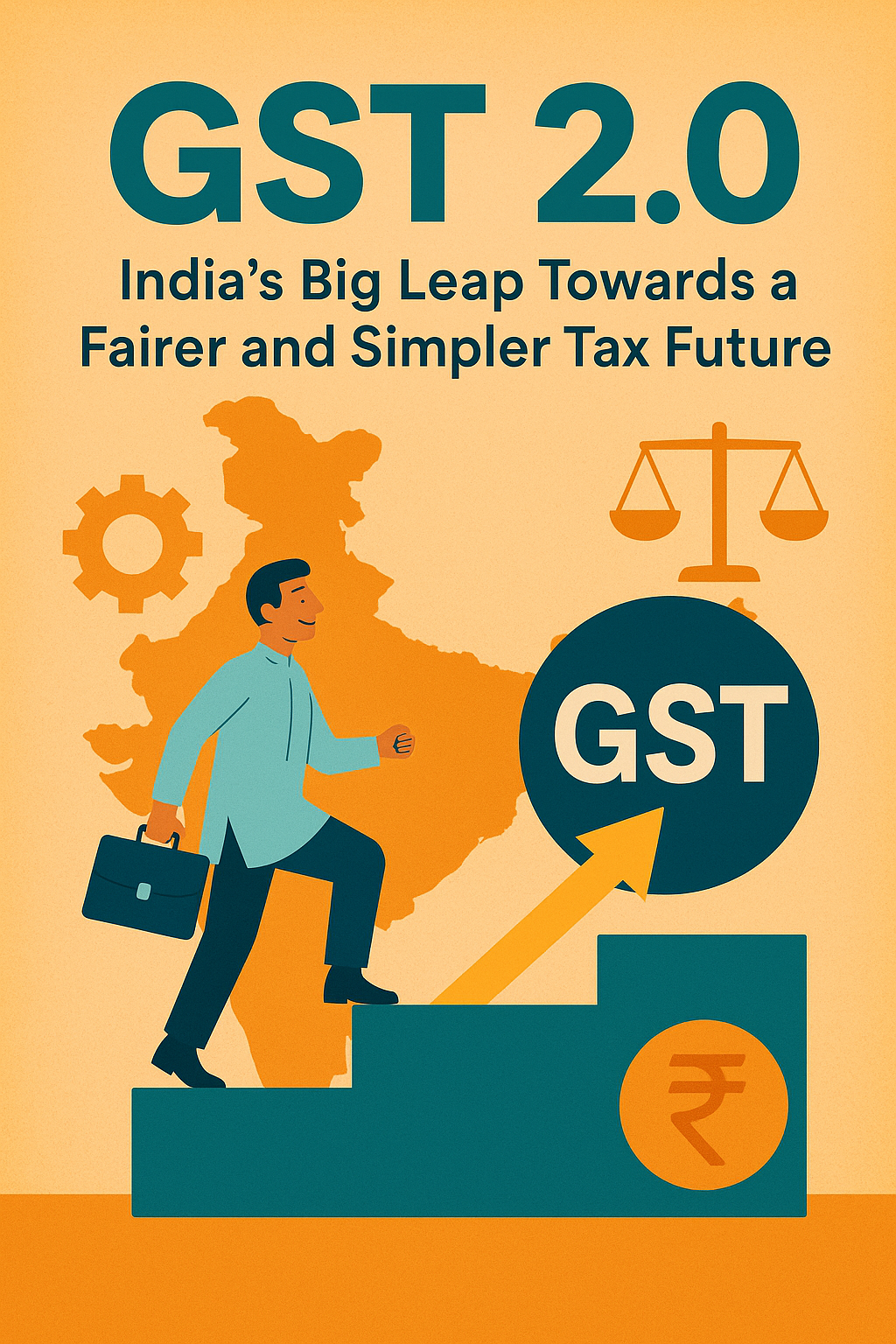By RAVI KUMAR THAKUR LLB LOVELY PROFESSIONAL UNIVERSITY
Imagine a mother buying monthly groceries, a student preparing for exams, a farmer investing in irrigation equipment, and a middle-class family saving up for a refrigerator. All of them have one thing in common—the impact of GST on their pockets. When GST was first introduced in 2017, it promised to simplify life by bringing a common tax regime to India. Over the years, however, the multiple slabs, disputes, and complexities slowly turned that dream into a burden. Now, GST 2.0 aims to correct course, delivering real relief and restoring the original vision.
India has launched its most ambitious Goods and Services Tax (GST) reform since the system’s inception in 2017, marking a turning point in the country’s indirect taxation journey. Called GST 2.0, this reform is more than a policy shift—it is a bold attempt to simplify taxes, ease the lives of ordinary citizens, and nurture growth for businesses across the spectrum.
Why India Needed GST 2.0
When GST first arrived, it was hailed as the promise of “one nation, one tax.” But over time, its four slab structure—5%, 12%, 18%, and 28%—turned into a jungle of complications. Businesses constantly struggled with disputes on product classifications, consumers rarely knew which slab applied where, and MSMEs were drowned in compliance. The vision of a clean, predictable tax system blurred under the weight of complexity.
The call for change became impossible to ignore. GST 2.0 answers that call by bringing clarity, breathing space, and fairness back into the tax regime.
GST 2.0 marks one of India’s most significant reforms in indirect taxation since the GST was first introduced in 2017. The earlier four-slab structure of 5%, 12%, 18%, and 28% created more confusion than clarity, resulting in frequent disputes on product classification, uneven tax burdens, and increasing compliance costs for businesses, especially MSMEs and startups. With GST 2.0, the government has restructured the system into three simple slabs—5% on essentials, 18% as the new standard rate, and 40% for sin and luxury goods. This shift not only removes ambiguity but also directly impacts household budgets. Essentials like toiletries, dairy products, medicines, agricultural inputs, and educational supplies now fall under the lowest slab, easing costs for families, students, and farmers alike. Middle-class aspirations are also supported, as durable goods such as refrigerators, cars, and electronics move from the 28% slab to 18%. On the other hand, ultra-luxury cars, gambling, and aerated drinks attract the punitive 40% slab, reflecting the social intent of discouraging harmful consumption. Beyond rates, compliance has gone digital with pre-filled returns, faster refunds, and simpler registrations, reducing the red tape that burdened small businesses. Overall, GST 2.0 delivers consumer relief, encourages demand, and establishes a fairer, growth-oriented tax system.
Sources
The New Three-Slab Structure
From September 22, 2025, GST has been dramatically simplified to just three slabs:
– 5% on daily essentials
– 18% as the standard slab for most goods and services
– 40% for luxury and socially harmful products, called the “de-merit slab”
By removing the 12% and 28% categories, the government has cleared away the grey areas that created constant confusion and disputes.
What Gets Cheaper
For households, GST 2.0 isn’t just a tax reform—it’s real relief in the shopping basket.
– Everyday items like toothpaste, shampoo, soap, hair oil, and shaving cream are now at 5%, down from 18%.
– Food and nutrition: Butter, cheese, ghee, baby food, feeding bottles, and diapers are now cheaper.
– Healthcare: Insurance, medical kits, diagnostic tools, thermometers, and eyewear are either 5% or zero-rated.
– Farm sector: Tractors, fertilizers, micro-nutrients, and drip irrigation equipment are now more affordable for farmers.
– Education: Textbooks, maps, and stationery are at 5% or 0%, helping families and students.
For the middle class, this is almost like an indirect pay raise—more savings, easier access to essentials, and reduced household stress.
Support for the Middle Class
For years, air-conditioners, refrigerators, dishwashers, televisions, and cars wore the burden of the 28% tax slab. In GST 2.0, these have shifted to 18%. This is a big win for middle-class families who aspire to upgrade their homes and lifestyles without burning a hole in their pockets.
What Gets Costlier
The flip side of relief is moderation on extravagance. GST 2.0 introduces a 40% slab—the highest ever—for luxury and sin goods:
– High-end cars and SUVs
– Aerated beverages
– Gambling, betting, casinos
Tobacco remains saddled with the 28% GST plus cess, and indications are it may soon join the 40% bracket. The message is clear: essentials and aspirations deserve encouragement, but harmful or ultra-luxury consumption must pay a price.
Digital-first Compliance
One of the most radical shifts is not just what we pay but how we pay. GST 2.0 embraces technology fully:
– Pre-filled GST returns and automated input credit matching
– Swift, mostly automatic refunds
– Hassle-free registration, especially for MSMEs and startups
This overhaul cuts red tape, reduces human interaction, and promises faster, cleaner, and more transparent compliance.
Why This Reform Matters
The government hopes GST 2.0 will:
– Ease inflationary pressure by lowering taxes on essentials
– Boost consumption by making durable goods more affordable
– Provide certainty for businesses by reducing tax disputes
– Help MSMEs and farmers compete on a fair basis
– Fuel domestic manufacturing by fixing the problem of inverted duty
Winners and Losers
Winners:
– Everyday consumers, who will feel the effect in their grocery, healthcare, and education bills.
– Farmers, with inputs becoming cheaper.
– Students and working families, who can stretch their budgets further.
– MSMEs and startups, no longer suffocated by compliance headaches.
– Industries relying on mass consumption—FMCG, autos, electronics—will see growth.
Losers (or rather, higher payers):
– The luxury class, with higher-cost SUVs, betting, and lavish indulgences.
– Governments in the short term, as collections may dip (an anticipated ₹48,000 crore gap). However, the expectation is that higher consumption and smoother compliance will balance this out later.
The Bigger Picture
Economists estimate that GST 2.0 could slash retail inflation by up to 1.1 percentage points, a critical respite in a time of rising fuel and food prices. Domestic manufacturers are also poised to gain, as tax distortions between components and finished goods ease out.
On a social level, the reform ensures fairness: affordable food, medical access, and education support the weaker sections, working women, and students—directly touching lives.
The Road Ahead
The reform is not without risks. Heavy reliance on indirect taxes remains a worry, states with larger consumption bases may face temporary dips, and tax evasion risks linger. The promise of regular reviews by the GST Council and strong digital infrastructure will be crucial to sustaining confidence.
Conclusion: More Than Just a Tax Cut
GST 2.0 is more than a tax reshuffle. It is about trust, fairness, and predictability. For the common man, the relief comes in everyday purchases; for businesses, it comes in lower compliance costs; for the economy, it promises a virtuous cycle of higher demand, better growth, and inclusive progress.
This is not just a reform—it is a landmark in India’s economic history, a renewed attempt to make “one nation, one tax” simple, meaningful, and humane.



